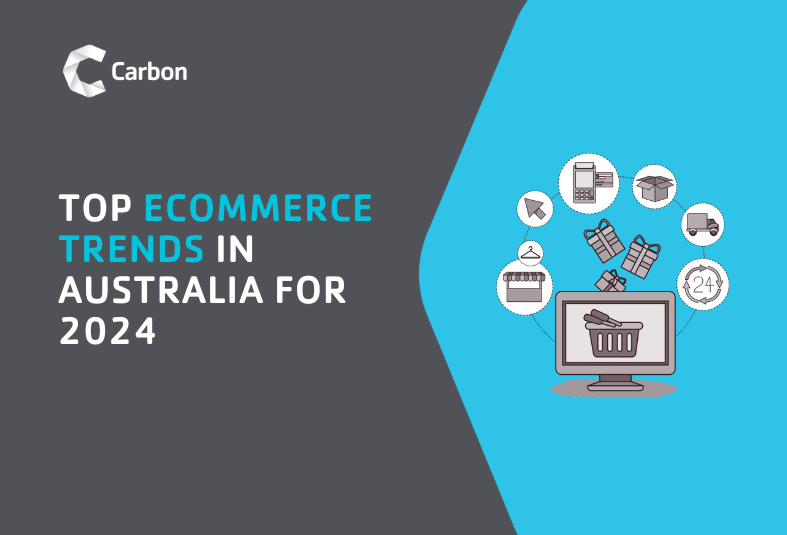In the Australian retail landscape, eCommerce emerges as the antidote to the headaches of traditional shopping. The quest for a more convenient and efficient shopping experience has driven a surge in online commerce. As we enter 2024, this shift from physical stores to virtual marketplaces is not just a fleeting trend but a fundamental reshaping of how Australians shop.
The decision to embrace eCommerce is not solely about avoiding the slow checkout dance. It’s about sidestepping the labyrinthine aisles, the scarcity of parking spaces and the perpetual search for an available cashier. It’s about reclaiming your time and sanity in a world where convenience is king.
In exploring the top eCommerce trends for 2024, we’ll uncover the digital shifts shaping the way Australians shop. From tech innovations to changes in consumer behaviours, immerse yourself in the world of Australian eCommerce – where the checkout process is as swift as a click and the possibilities are as vast as the digital landscape itself.
Table of Contents
Overview of Current eCommerce Landscape in Australia
To understand the trajectory of eCommerce in Australia for 2024, let’s first take a look at the current landscape.
Market Size and Growth Projections
The eCommerce market in Australia is on an upward trajectory that promises significant growth in the coming years.
According to Australia Post and CommBank iQ, here are some important statistics:
- Total Retail Spending (2022): Aussies spent a record $353 billion on retail goods in 2022, marking a remarkable 9.2% increase compared to 2021.
- Online Share of Retail Spend: 18.1%
- Online Goods Spend: $63.8 billion, up by 1.7% Year over Year (YoY)
- Household Online Purchases (2022): 82% of Australian households made an online purchase, representing 9.4 million households, which is an increase of 1.6% YoY.
- Monthly Online Purchases: On average, 5.6 million households made an online purchase each month.
- Future Projections: By 2033, it is anticipated that around 1 in 3 dollars will be spent online.
These figures underscore the widespread adoption of eCommerce across various sectors. From fashion and electronics to groceries and healthcare, Australians are embracing online platforms for a diverse range of shopping needs.
Shifting Consumer Behaviour
In 2022, Australians experienced a notable shift in consumer behaviour as the nation shifted back to pre-pandemic norms. With a record retail spending of $353 billion, indicating a substantial 9.2% year-over-year increase, consumers actively engaged in face-to-face activities and returned to physical stores. This surge was driven by factors such as price inflation and a renewed interest in in-store shopping. Notably, the easing in online penetration during 2022 suggested a return to the normal trend of growth, indicating that while online volumes did not decrease, the pace of growth slowed compared to the peak experienced during pandemic restrictions.
Despite the moderation in online growth, there was a noteworthy increase in household participation in online shopping, as consumers grew more comfortable with the digital retail experience. Super Shoppers, constituting 16% of households, emerged as key players in this evolving landscape. These savvy consumers made weekly online purchases, contributing to half of all online transactions. This shift was indicative of a broader transformation in consumer habits, showcasing a hybrid approach to retail where both physical and online channels coexisted.
As the retail landscape continued to evolve in 2023, cost-of-living pressures began impacting consumer sentiment, prompting a more cautious approach to spending. This change led to short-term challenges for retailers, emphasising the need to focus on customer loyalty. With consumers becoming more discerning, retailers must adapt strategies to meet evolving expectations, ensuring a seamless and personalised shopping experience to retain customer trust and engagement. As the eCommerce landscape in Australia moves forward into 2024, understanding and responding to these shifting consumer behaviours will be crucial for businesses aiming to thrive in the dynamic marketplace.
The Rise of Local Players
While global eCommerce giants continue to make their mark in Australia, local players are gaining prominence. Homegrown businesses are leveraging their understanding of the local market, fostering a sense of community and trust among Australian consumers. This dynamic blend of international and local competition is shaping a diverse and robust eCommerce ecosystem.
Technology and Innovation
Technological advancements not only elevate the shopping experience but also empower businesses to operate more efficiently. As we progress through 2024, the integration of technology will continue to redefine the contours of Australian eCommerce.
Advanced Payment Solutions
The checkout process is undergoing a revolution with advanced payment solutions at the forefront. Australians can now bid farewell to the hassles of entering lengthy card details with the rise of seamless and secure payment options. From digital wallets to one-click payments, these innovations not only expedite transactions but also enhance overall customer satisfaction.
Streamlining Transactions: Major eCommerce platforms are integrating biometric authentication, such as fingerprint and facial recognition, ensuring a secure yet frictionless payment experience for users.
Artificial Intelligence (AI) Integration
Artificial Intelligence is no longer a buzzword; it’s a game-changer in the eCommerce landscape. From personalised product recommendations to chatbots offering real-time assistance, AI is shaping a more responsive and intuitive online shopping experience.
On the Front Lines: Leading retailers are deploying AI-powered chatbots that understand customer queries, provide product information, and even assist in the decision-making process, replicating the guidance one might receive from an in-store assistant.
Enhanced Virtual Shopping Experiences
Virtual and augmented reality technologies are carving a niche in the eCommerce space, bringing an immersive dimension to online shopping. Consumers can now virtually try on clothing, visualise furniture in their homes or even experience products before making a purchase.
Transforming the Shopping Journey: Fashion retailers are employing augmented reality fitting rooms, allowing customers to virtually try on clothes and assess how they fit and look.
Mobile Commerce (M-Commerce) Trends
In a world where smartphones have become an extension of ourselves, the surge in Mobile Commerce (M-Commerce) is reshaping how Australians interact with online retail. The convenience of shopping at your fingertips is not merely a trend but a fundamental shift in consumer behaviour that continues to gain momentum as we venture into 2024.
The Pervasive Influence of Mobile Shopping Apps
Mobile shopping apps have become the go-to companions for Australian consumers. The ease of browsing, the convenience of one-tap purchases, and personalised recommendations have elevated the mobile shopping experience. As a result, these apps are not just platforms for transactions; they are immersive portals connecting users to a curated world of products and services.
Statistics Snapshot: Recent research reveals the prevalence of mobile shopping app usage across various age groups:
- Retail brand shopping apps are used by at least two-fifths of consumers aged 25-44, and around a third of consumers aged 18-24 and 45-54.
- ECommerce platform apps are most popular among consumers aged 35-44, where close to half presently use them. In contrast, current usage among consumers aged 25-34 and 45-54 is around two in five and less than a quarter of consumers aged 18-24 and 55 years or older.
- Among consumers who use dedicated mobile shopping apps, 60% have between two to four apps installed on their phones, while almost a fifth have more than five apps.
Changing Consumer Behaviour
The mobile-first approach is not just a matter of device preference; it’s indicative of a broader shift in consumer behaviour. Australians now expect seamless transitions between devices, starting a shopping journey on a laptop and seamlessly concluding it on a smartphone. This fluidity underscores the importance of optimising the entire customer journey for mobile devices.
Highlighting the Transition: Retailers investing in responsive design and mobile-friendly interfaces are aligning with the evolving preferences of mobile-savvy consumers.
The Role of Mobile Payments
Mobile payments are at the forefront of the M-Commerce revolution. The ease of making secure transactions through mobile wallets and contactless options has not only accelerated the checkout process but has also transformed the way Australians manage their finances.
Showcasing Payment Evolution: The adoption of mobile payment options, such as Apple Pay and Google Pay, has seen a significant uptick, reflecting the growing trust and acceptance of these technologies among consumers.
Sustainability in eCommerce
As consumers become more conscious of their ecological footprint, businesses are adapting, innovating and embracing eco-friendly practices. The pursuit of sustainability isn’t just a commendable gesture; it’s becoming a pivotal factor influencing purchasing decisions in 2024.
Eco-Friendly Practices in Action
Australian eCommerce businesses are actively implementing sustainability measures across their operations. From packaging to supply chain management, a wave of eco-conscious initiatives is reshaping the industry.
Example: Leading players like Amazon are actively reducing single-use plastics in packaging, opting for recyclable materials, and incorporating eco-friendly alternatives. This commitment aligns with environmental goals and resonates positively with environmentally-aware consumers.
The Cost-Effectiveness of Sustainable Practices
Contrary to the perception that sustainability comes at a hefty price, businesses are finding that eco-friendly practices can be economically viable. Adopting sustainable measures not only contributes to environmental well-being but also enhances operational efficiency and long-term cost-effectiveness.
Case in Point: Companies investing in energy-efficient technologies and sustainable sourcing are not only reducing their environmental impact but are also benefiting from cost savings in the long run.
Social Commerce
This fusion of social media and online shopping is reshaping how Aussies discover and purchase products. From Instagram boutiques to TikTok’s retail revolution, social platforms are now dynamic marketplaces. In this section, we explore the trends and strategies propelling Social Commerce to the forefront of the Australian online retail scene, revealing how businesses are leveraging these shifts for increased sales and consumer engagement.
The Power of User-Generated Content
Australians are increasingly relying on the recommendations, reviews and experiences shared by their peers on social media platforms. This shift from traditional advertising to authentic user experiences has turned social media into a bustling marketplace where trust is cultivated through shared narratives.
Emphasis on Authenticity: In the world of Social Commerce, authenticity reigns supreme. Businesses fostering genuine connections and showcasing real-life product usage resonate more profoundly with the audience.
Influencer-Driven Marketing Dynamics
The influencer culture continues to shape consumer behaviour, driving purchasing decisions and brand loyalty. However, the landscape is evolving with consumers becoming more discerning about influencer partnerships. Transparency and ethical considerations play a crucial role as influencers become key players in the eCommerce ecosystem.
Ethical Considerations: As influencers become pivotal in shaping purchasing decisions, there is a growing emphasis on ethical practices. Consumers appreciate transparency and brands collaborating with influencers who align with their values are gaining favour.
Challenges in the Social Commerce Arena
While Social Commerce presents exciting opportunities, it also comes with its set of challenges. The saturation of influencer-driven marketing, potential authenticity concerns, and the ever-evolving algorithms of social media platforms necessitate a nuanced approach. Businesses need to navigate these challenges carefully to build sustainable and genuine connections with their audience.
Navigating Challenges: To overcome challenges, businesses are focusing on building long-term relationships with influencers, prioritising authenticity overreach and adapting to the evolving social media algorithms.
Data Security and Privacy
In the digital age, where information flows seamlessly, ensuring robust data security and safeguarding user privacy are paramount for a thriving eCommerce ecosystem. As we delve into the eCommerce trends shaping Australia in 2024, it’s crucial to examine the measures businesses are adopting to protect sensitive data and foster trust among their customers.
Data Security Measures and Technologies
The prevalence of cyber threats underscores the importance of implementing comprehensive data security measures. Australian eCommerce businesses are increasingly adopting advanced technologies to fortify their defences against potential breaches. Secure socket layer (SSL) encryption, multi-factor authentication and regular security audits are becoming standard practices to safeguard customer information.
Best Practices: Leading eCommerce platforms are investing in regular cybersecurity training for their teams, ensuring employees are equipped to identify and thwart potential security threats.
Learning from Data Breach Incidents
Recent years have seen high-profile data breaches that have underscored the vulnerabilities inherent in the digital landscape. Learning from these incidents is crucial for the eCommerce sector. By studying the causes and consequences of data breaches, businesses can proactively strengthen their security protocols.
Incident Response Plans: Establishing robust incident response plans is a key strategy. Rapid and transparent communication in the event of a data breach not only mitigates the impact but also enhances customer trust.
Balancing Personalisation with Privacy
While consumers appreciate personalised experiences, there is a delicate balance to strike between personalisation and privacy. Australian eCommerce businesses are navigating this balance by implementing data anonymisation, obtaining explicit consent for data usage and adhering to evolving privacy regulations.
Transparency Matters: Businesses that are transparent about their data collection practices and provide users with control over their preferences are building stronger relationships based on trust.
Cross-Border eCommerce
Cross-Border eCommerce has emerged as a defining trend in Australia’s online retail landscape. As we venture into 2024, businesses are exploring international markets, leveraging technology to overcome geographical barriers and tapping into the vast opportunities offered by cross-border trade.
Australian Businesses Going Global
A notable shift is observed as Australian eCommerce businesses expand their reach beyond domestic borders. The allure of international markets and the potential for increased customer bases are prompting businesses to explore global opportunities.
Recent insights from Adyen, a global card payments company, reveal a noteworthy surge among Australian merchants eyeing new overseas markets for online sales. The proportion has nearly doubled this year, escalating from 20 percent in 2022 to 39 percent in 2023. This trend isn’t exclusive to corporate giants; even smaller enterprises are capitalising on online platforms’ accessibility and reach.
Changes in International Trade Agreements
The dynamics of cross-border eCommerce are influenced by changes in international trade agreements. Ongoing negotiations and updates in trade policies can impact the ease of conducting business across borders. Staying informed about these changes is crucial for businesses seeking to navigate the regulatory landscape of international commerce.
Impact of Trade Agreements: Recent trade agreements, like the Australia-United Kingdom Free Trade Agreement, have played a crucial role in facilitating smoother cross-border transactions for Australian businesses. These agreements work to reduce barriers and streamline processes, enhancing the overall efficiency of international trade.
Leveraging Technology for Global Expansion
Technology plays a pivotal role in facilitating cross-border eCommerce. From efficient logistics and payment gateways to multilingual customer support, businesses are leveraging a range of technological solutions to overcome the challenges associated with global expansion. Seamless online experiences, language localisation and secure international transactions are becoming the norm.
Technological Integration: Businesses are integrating advanced technologies, such as AI-driven translation services and global payment gateways, to ensure a seamless experience for international customers.
Customer Experience and Personalisation
As we explore the trends shaping 2024, the spotlight turns to the pivotal role of Customer Experience (CX) and the art of personalisation in fostering lasting connections with online shoppers.
The Rise of Chatbots and Virtual Assistants
Chatbots and virtual assistants have become integral to enhancing customer experience. These AI-powered entities serve as round-the-clock assistants, providing instant responses to queries, guiding customers through the purchase process and offering personalised recommendations.
Role of Chatbots: Businesses are increasingly leveraging chatbots to streamline customer interactions, resolve queries promptly and create a more responsive online environment. The result? Enhanced customer satisfaction and increased operational efficiency.
Data-Driven Personalisation
Personalisation is no longer a buzzword; it’s a fundamental aspect of the online shopping journey. By leveraging customer data, businesses can tailor product recommendations, marketing messages and even website interfaces to align with individual preferences. This not only improves the overall shopping experience but also boosts conversion rates.
Enhancing Customer Journeys: Leading eCommerce platforms use data analytics to analyse user behaviour, predict preferences and curate personalised shopping experiences. This data-driven approach can significantly increase customer engagement and loyalty.
Striking the Balance
While personalisation is a powerful tool, it’s essential to strike the right balance. Respecting user privacy and being transparent about data usage are critical considerations. Customers appreciate personalisation that enhances their experience without compromising their privacy.
Strategies for Balance: Businesses are adopting opt-in personalisation models, allowing customers to control the level of personalisation they receive. Clear communication about data usage policies builds trust and fosters positive customer relationships.
FAQs
The eCommerce landscape in Australia has undergone a significant transformation, marked by a surge in online shopping. In 2022, Australians spent a record $353 billion on retail goods, with online spending accounting for 18.1% of total retail spend. The shift is not just a trend but a fundamental reshaping of how Australians shop.
The growth of eCommerce in Australia is driven by the quest for a more convenient and efficient shopping experience. Factors include avoiding the hassles of traditional stores, embracing advanced payment solutions and the rise of local players offering a diverse online shopping experience.
In 2022, there was a notable shift in consumer behaviour as Australians returned to physical stores. Despite a moderation in online growth, household participation in online shopping increased, with Super Shoppers making weekly online purchases. As of 2023, cost-of-living pressures are influencing a more cautious approach to spending.
Technology plays a pivotal role in reshaping the Australian eCommerce landscape. Innovations like advanced payment solutions, artificial intelligence (AI) integration, and virtual shopping experiences are enhancing the overall online shopping experience, making transactions more secure and convenient.
M-Commerce is reshaping how Australians interact with online retail, with mobile shopping apps becoming go-to companions. Consumers expect seamless transitions between devices, and businesses are investing in responsive design to align with the preferences of mobile-savvy consumers.
Australian eCommerce businesses are actively implementing sustainability measures, from eco-friendly packaging to supply chain management. Leading players, such as Amazon, are reducing single-use plastics and incorporating eco-friendly alternatives, aligning with environmentally-aware consumers.
Social Commerce, the fusion of social media and online shopping, is reshaping how Australians discover and purchase products. User-generated content and influencer-driven marketing dynamics are key trends, emphasising the importance of authenticity and ethical considerations.
Australian eCommerce businesses are adopting comprehensive data security measures, including SSL encryption, multi-factor authentication, and regular security audits. Learning from data breach incidents, businesses are establishing robust incident response plans and balancing personalisation with user privacy to build trust.
Australian eCommerce businesses are expanding their reach beyond domestic borders, leveraging technology to overcome geographical barriers. The proportion of Australian merchants eyeing new overseas markets has nearly doubled, reflecting a growing interest in global opportunities.
Changes in international trade agreements influence the dynamics of cross-border eCommerce in Australia. Recent agreements, like the Australia-United Kingdom Free Trade Agreement, work to reduce barriers and streamline processes, enhancing the efficiency of international trade.
Technology plays a pivotal role in facilitating cross-border eCommerce, addressing challenges related to logistics, payment gateways, and customer support. Businesses are integrating advanced technologies such as AI-driven translation services and global payment gateways to ensure a seamless experience for international customers.
Chatbots and virtual assistants have become integral in providing round-the-clock assistance to customers, offering instant responses, guiding through the purchase process, and providing personalised recommendations. Businesses leveraging chatbots experience enhanced customer satisfaction and increased operational efficiency.
Data-driven personalisation is a fundamental aspect of the online shopping journey. By leveraging customer data, businesses can tailor product recommendations, marketing messages, and website interfaces to align with individual preferences, significantly improving the overall shopping experience and boosting conversion rates.
Striking the right balance between personalisation and user privacy is crucial. Businesses adopt opt-in personalisation models, allowing customers to control the level of personalisation they receive. Clear communication about data usage policies builds trust and fosters positive customer relationships.
Conclusion
The Australian eCommerce landscape in 2024 signifies a notable shift in how consumers shop and businesses operate. As digital platforms increasingly replace traditional retail experiences, this evolution is more than just a trend—it’s a practical and meaningful change.
From the adoption of advanced payment solutions to AI integration and a growing emphasis on sustainability, the industry is showcasing adaptability. In response to ongoing technological shifts, businesses are exploring opportunities in mobile and social commerce while gradually expanding into global markets.
Elevating customer experiences is at the forefront, with a focus on data security, privacy, and personalised services. The rise of chatbots, data-driven personalisation, and a careful balance between customisation and privacy highlight a commitment to forming meaningful connections with online shoppers.
As we step into 2024, the Australian eCommerce landscape stands as a testament to practical innovation, sustainability and customer-centric strategies. To navigate this evolving digital terrain successfully, businesses require adaptability, a solid understanding of consumer behaviours, and a commitment to delivering seamless and personalised shopping experiences.
For expert guidance in navigating the intricacies of the changing eCommerce landscape, consider reaching out to Carbon Group. Our team is ready to assist you in optimising your online business, enhancing your opportunities for success in the ever-expanding world of Australian eCommerce.





















